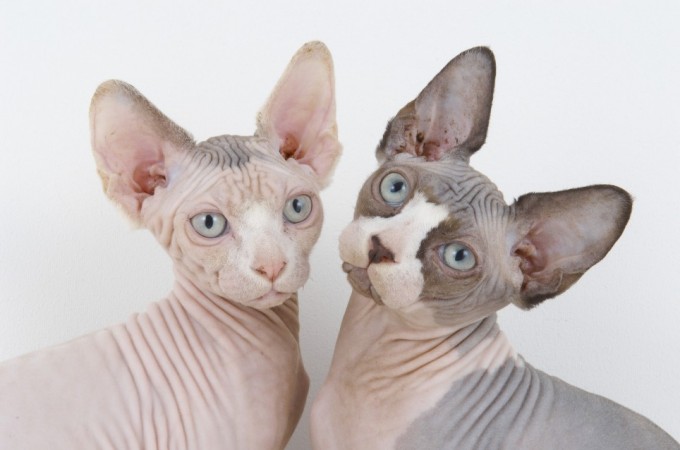The Cat Connection is busy preparing for its second Pop-Up Cat Café, which will be held on Saturday, August 15 from 11 AM to 4 PM. Our inaugural Café was a great success, raising $1,000 for Operation Kindness and helping to find three cats their forever homes! This weekend, the Café will be featuring a new rescue in need of exposure for their adoptable kitties: DFW Purebred and Domestic Cat Rescue. We hope to see you all there for a great day of complimentary coffee, cats and fun, all in support of another DFW rescue!
Who is DFW Purebred and Domestic Cat Rescue?
DFW Purebred and Domestic Cat Rescue is a unique rescue in that they specialize in purebred and purebred mixes. The rescue is able to pull these cats from high-volume shelters once their time has run out, and they also work with individuals who are no longer able to care for their purebred animals (though the group always encourages people in these situations to contact the cat’s breeder first, as breeders should assume responsibility for the animals they have bred, no matter how much time has elapsed).
While the Cat Connection firmly believes that all cats, regardless of their lineage, can make life-long friends, DFW Purebred and Domestic Cat Rescue and rescue groups like it are great options for those who fall in love with a particular breed, but would prefer to rescue the animal.
Fortunately, DFW Purebred and Domestic Cat Rescue gave us advance notice as to which breeds will be at Saturday’s Café! Many of the kitties this weekend will be adoptable, so this guide can give you some idea of what to expect. But please keep in mind that breed standards are simply guidelines, and individual cats may vary significantly from the standard. Basically, variety is the spice of life – for felines and humans!
Bengal
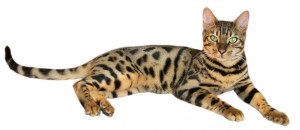
Origin: Riverside, California and other locations.
History: A hybrid breed, the Bengal’s breed foundation was formed through crossing the Asian Leopard cat with other domestic cats, including Egyptian Maus, Indian Maus and Abyssinians, American Shorthairs, Burmeses and other, non-pedigree cats. The Bengal gained recognition in 1986.
Physical description: Wild appearance with large, rounded eyes, a long neck and a muscular body. Medium to large cats with a soft and dense coat.
Colors: Only recognized in brown/black, spotted, and marbled, though other colors may exist.
Temperament: Not for the faint of heart, Bengals are intelligent and agile, but can be stubborn and headstrong
Activity level: High
Vocal level: High
Note: Breed recognition and legality of ownership due to the Bengal’s hybrid origins varies by location.
Oriental Shorthair
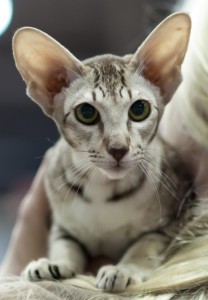
Origin: Britain & United States
History: Descriptions of Oriental Shorthair-like cats date back to the Thia book Cat Book Poems (1350 – 1767), though the breed was first developed in England dafter the Second World War. Siamese cats were crossed to Russian Blues, British Shorthairs and Abyssinians, sometimes being cross bred back to Siamese cats to produce colorpointed cats. The breed was imported into North America in the 1970s.
Physical description: Long, elegant but muscular bodies, with an elongated wedge-shaped head, large ears and almond-shaped eyes.
Colors: More than 300 colors and combinations possible.
Temperament: Intelligent, affectionate, inquisitive and mischievous. People-oriented and very, very vocal.
Activity level: High
Vocal level: Exceptionally high.
Persian
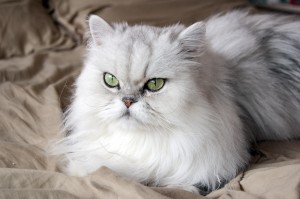
Origin: England
History: The first cat of cat fanciers in the mid-nineteenth century, the Persian was created through crossing several long-haired breeds, including Turkish Angoras, Russian longhairs and English longhaired domestic cats.
Physical description: Medium to large cat with substantial boning, small ears and short legs.
Colors: Many colors and patterns.
Temperament: Lap cat through and through.
Activity level: Low
Vocal level: Low
Note: Persians must be bathed and combed regularly, as their coat is prone to matting.
Sphynx
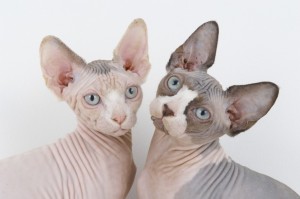
Origin: Ontario, Canada & Minnesota
History: In 1966, a hairless kitten named Prune was born in Toronto, Canada and formed the foundation of the modern Sphynx. Spontaneously occurring hairless kittens has subsequently been used to diversify the bloodline.
Physical description: Not entirely hairless, but rather covered in a soft, downy fur. Skin is wrinkled on the face, between the ears, and on the shoulders. Eyes are large and lemon-shaped. Body is muscular.
Colors: All colors are possible.
Temperament: Love to be in laps and under the covers – anywhere that is warm.
Activity level: High
Vocal level: Medium
Note: Contrary to many claims, the Sphynx is not hypoallergenic due to the fact that the allergen is not caused by the fur itself, but rather the Fel d1 protein secreted in the saliva of all cats. Sphynx cats require regular bathing, as hair growth does not pull skin secretions from the skin. Exposure to sharp objects and other hazards should be avoided, as the cat does not have a coat of fur to protect it.
Toyger
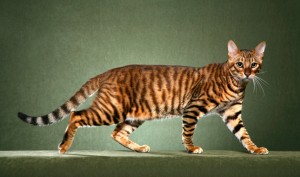
Origin: California
History: The Toyger was designed to resemble a small tiger, with a mackerel tabby domestic shorthair, a Bengal, and a street cat from Kashmir, India forming the foundation of the breed in the late 1980’s. Its unique look was conceptualized using computer graphics, the first of its kind.
Physical description: Medium-sized, muscular and long-bodied. Eyes are small to medium sized.
Colors: Resembles a tiger, with the tail having a blunted tip.
Temperament: Sweet and affectionate. Very playful, but can be headstrong. Their intelligence makes them trainable, particularly to walk on a leash.
Activity level: High
Vocal level: High
Examples of all of these breeds, many of whom will be adoptable, will be at Saturday’s Café. We look forward to seeing you there!
And please, if you do choose to use a breeder rather than rescuing, be sure to do your homework and locate a responsible one. For more information, check out these guidelines from the Canadian Federation of Humane Societies on selecting a breeder for a cat or dog. A little bit of research up front can save you, as well as countless generations of animals, a lot of heartache later on.
Note: All breed descriptions are reworked from Sandy Robins’ The Original Cat Fancy Cat Bible (2014, i-5 Publishing)


















